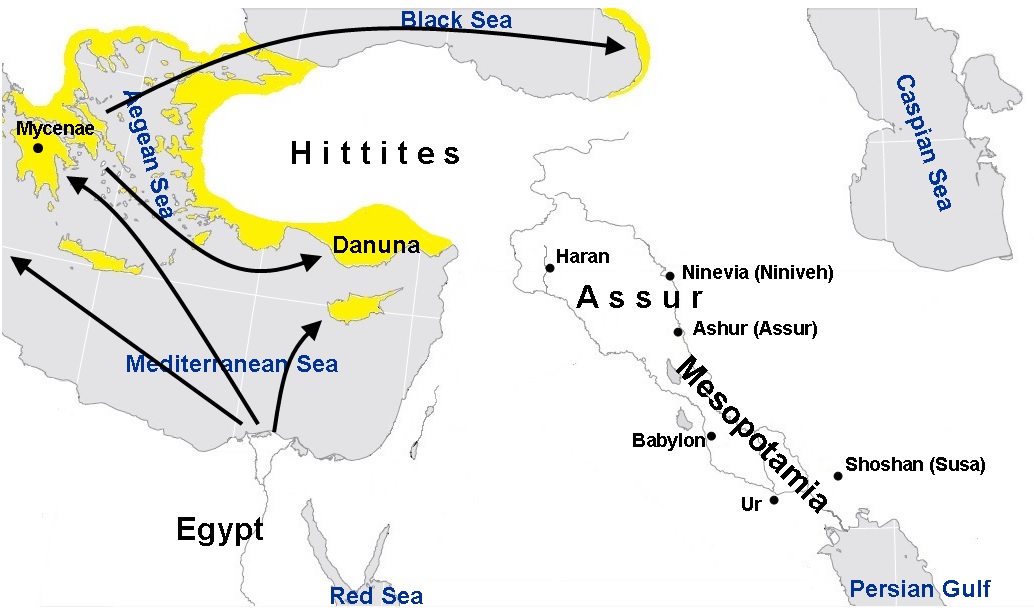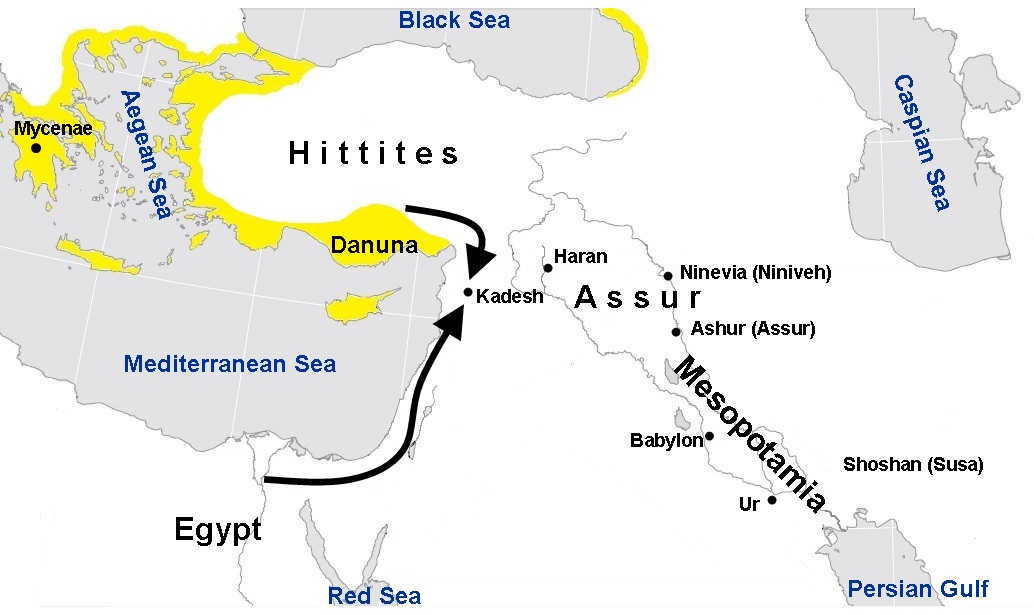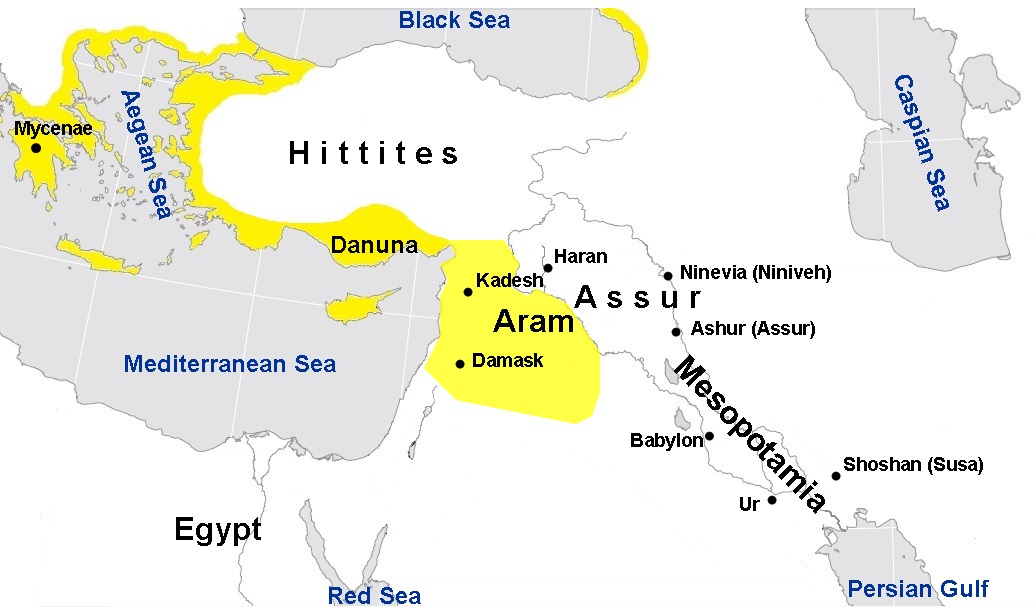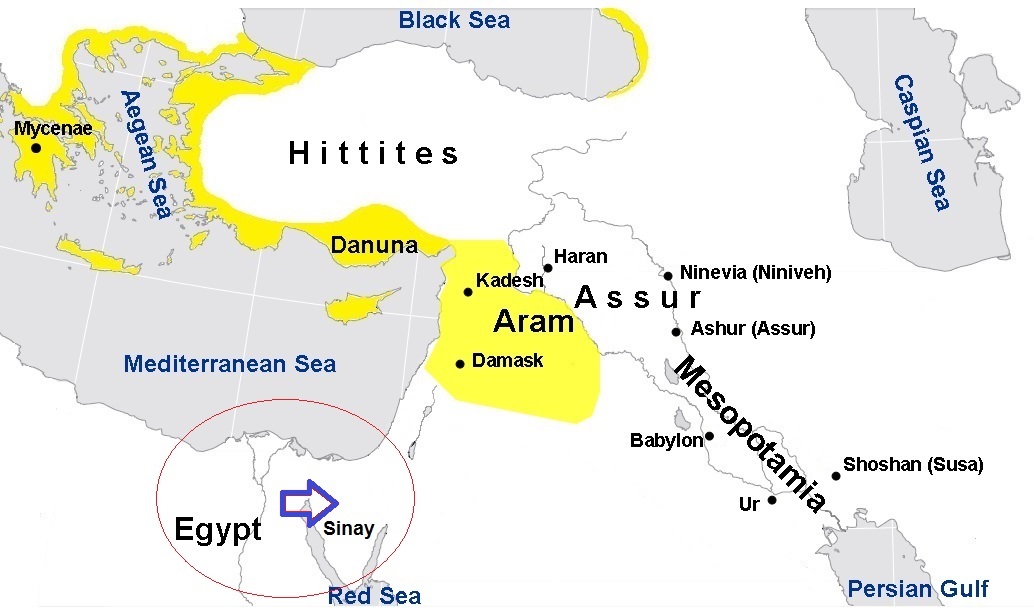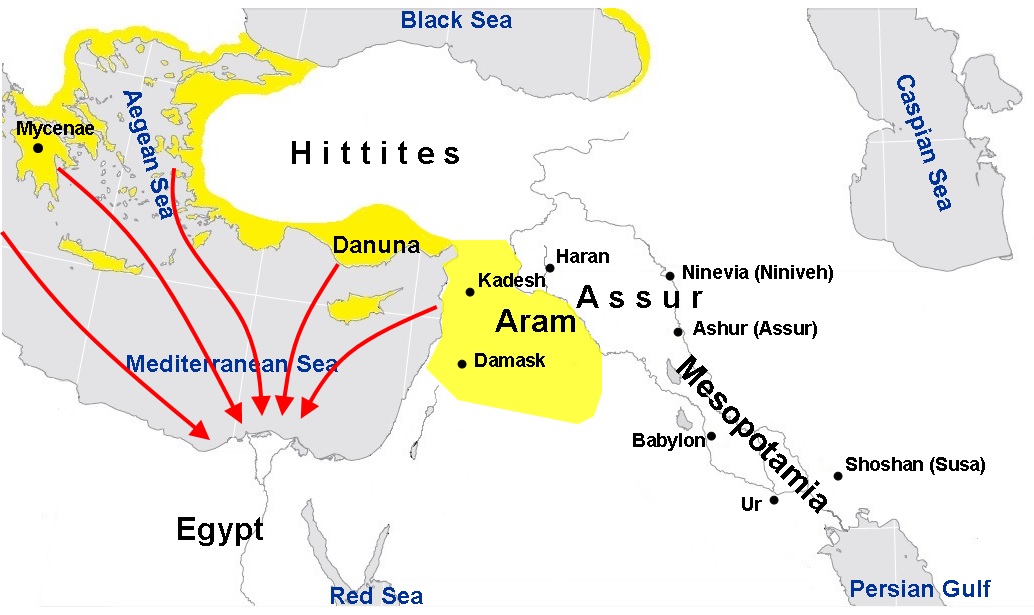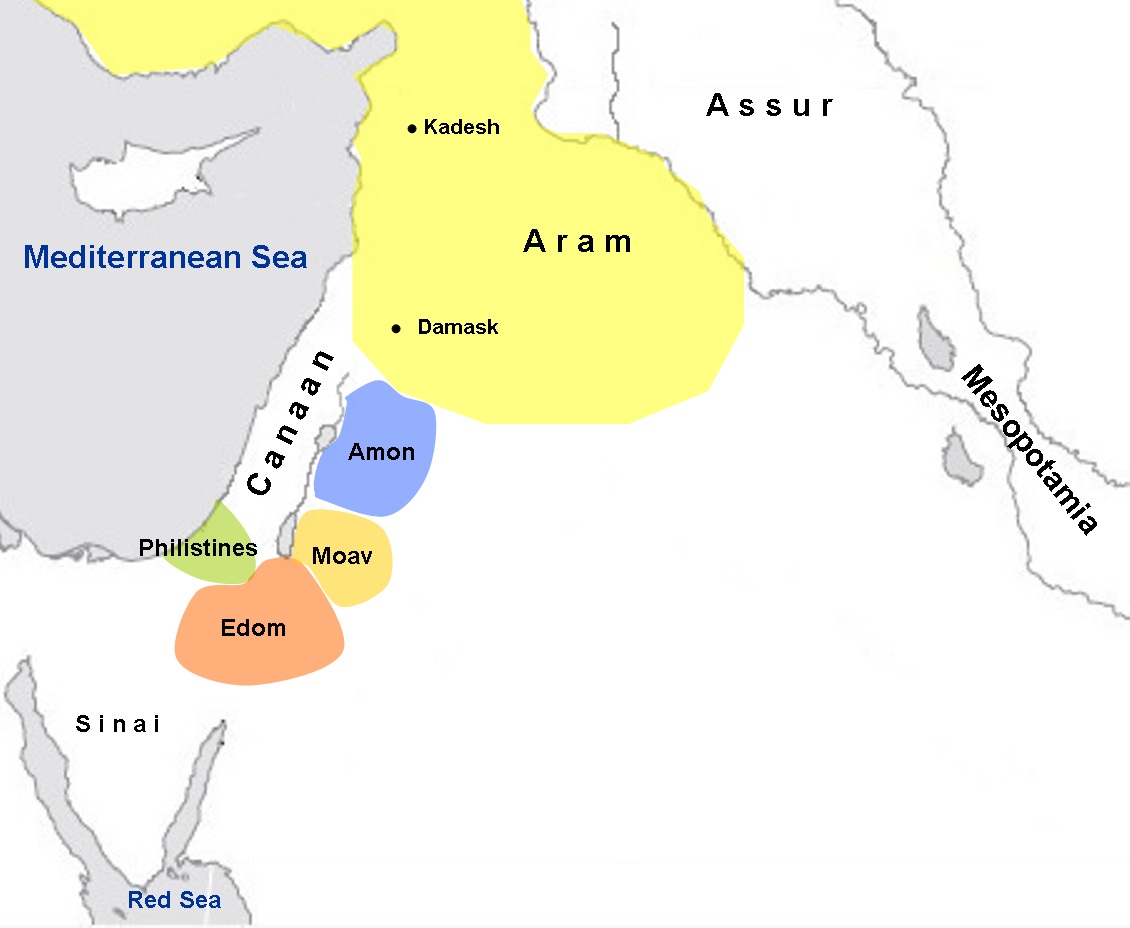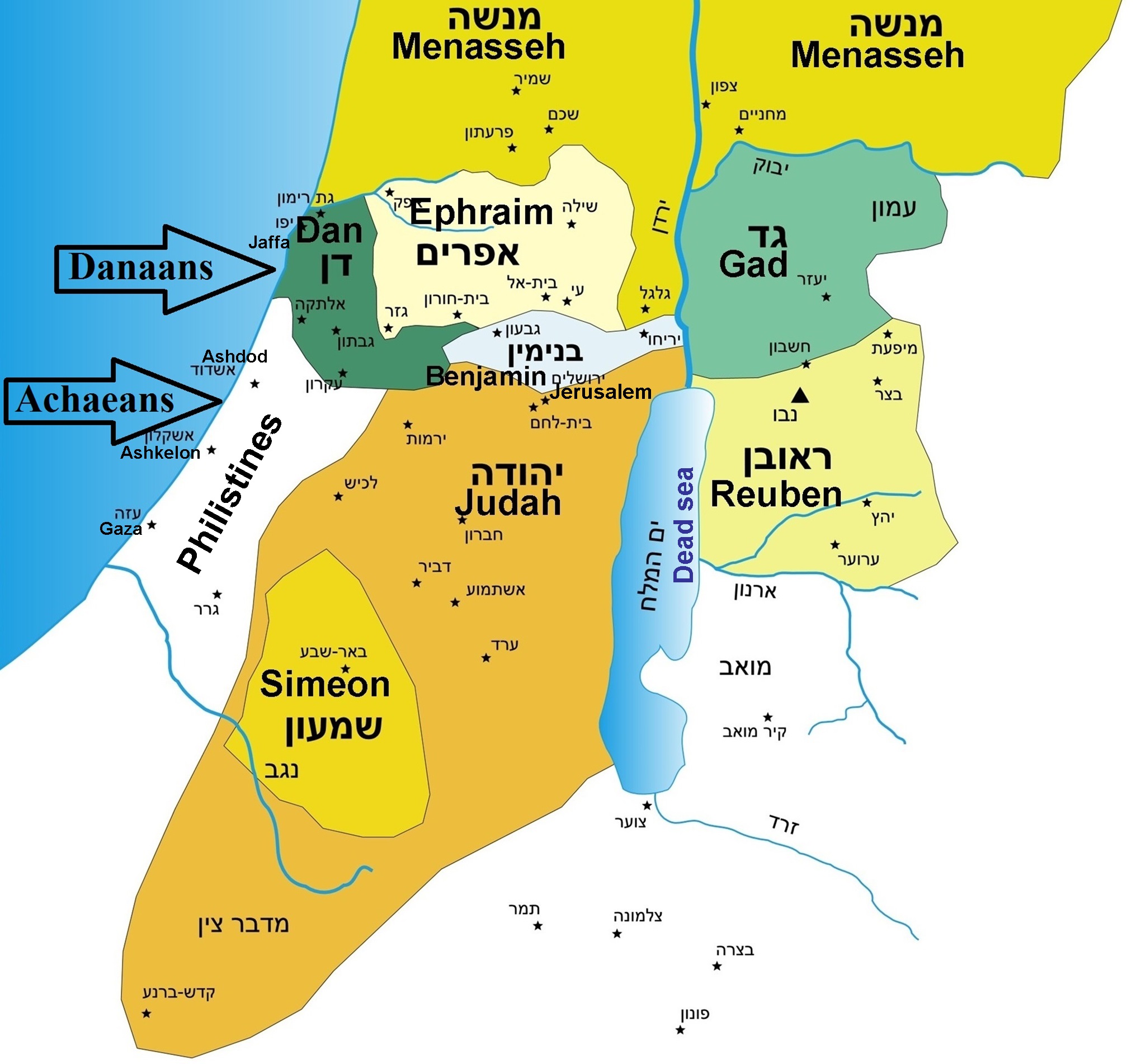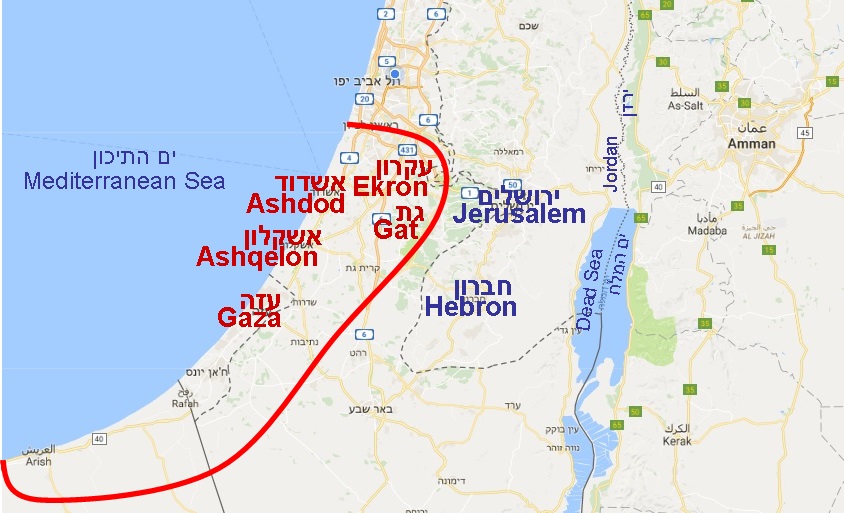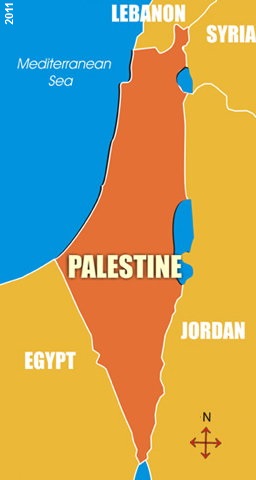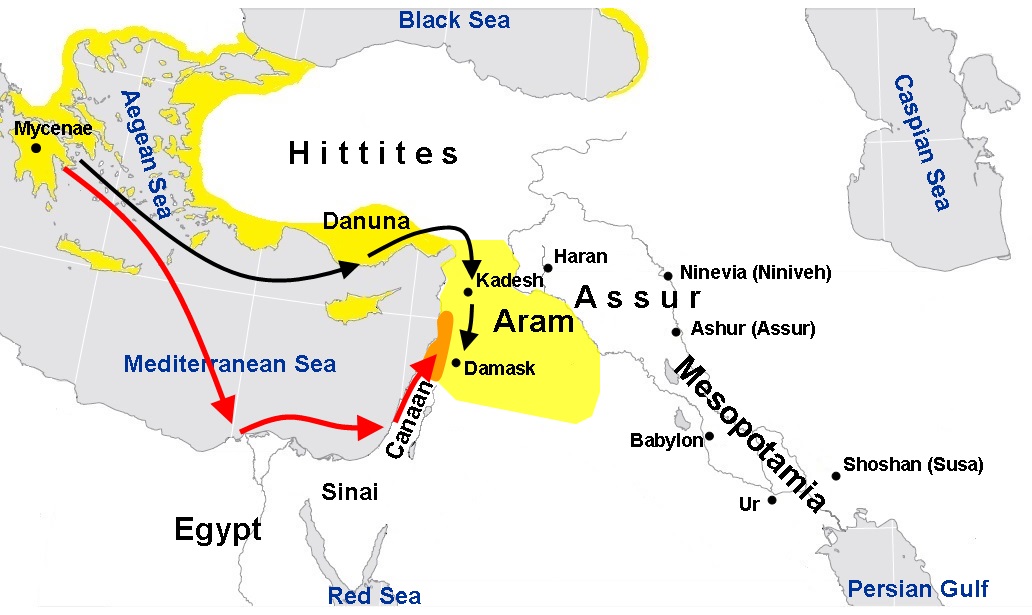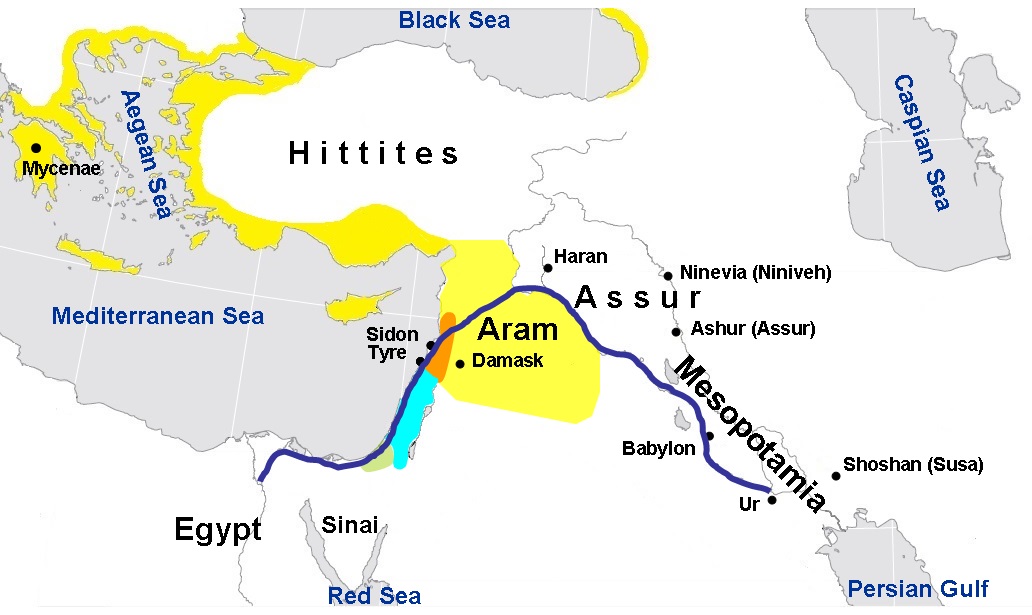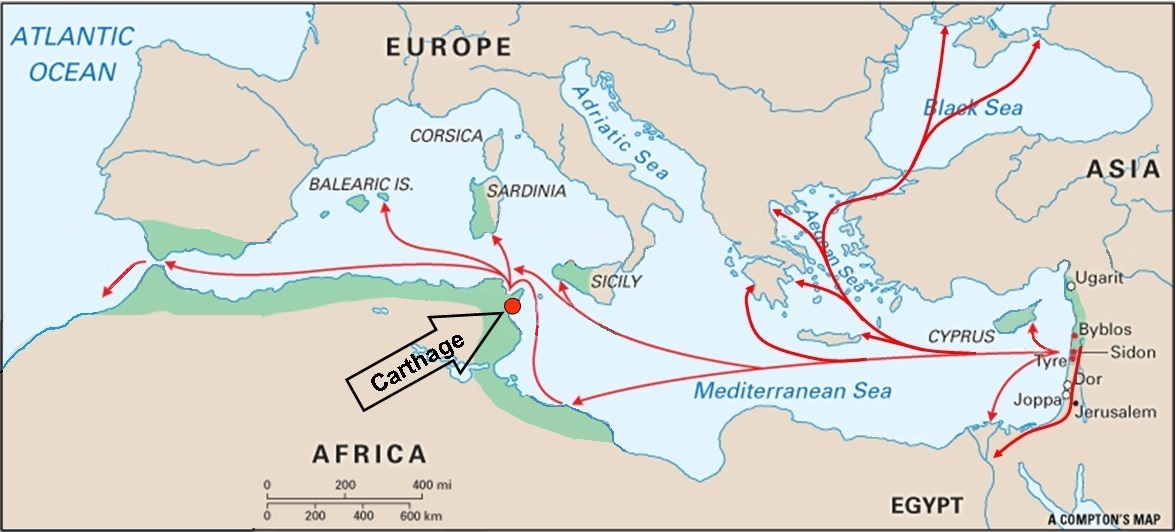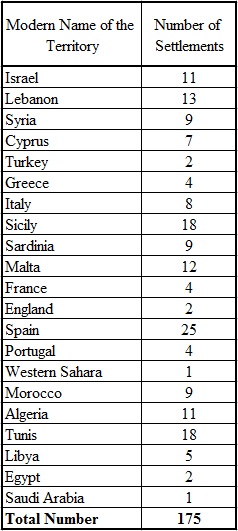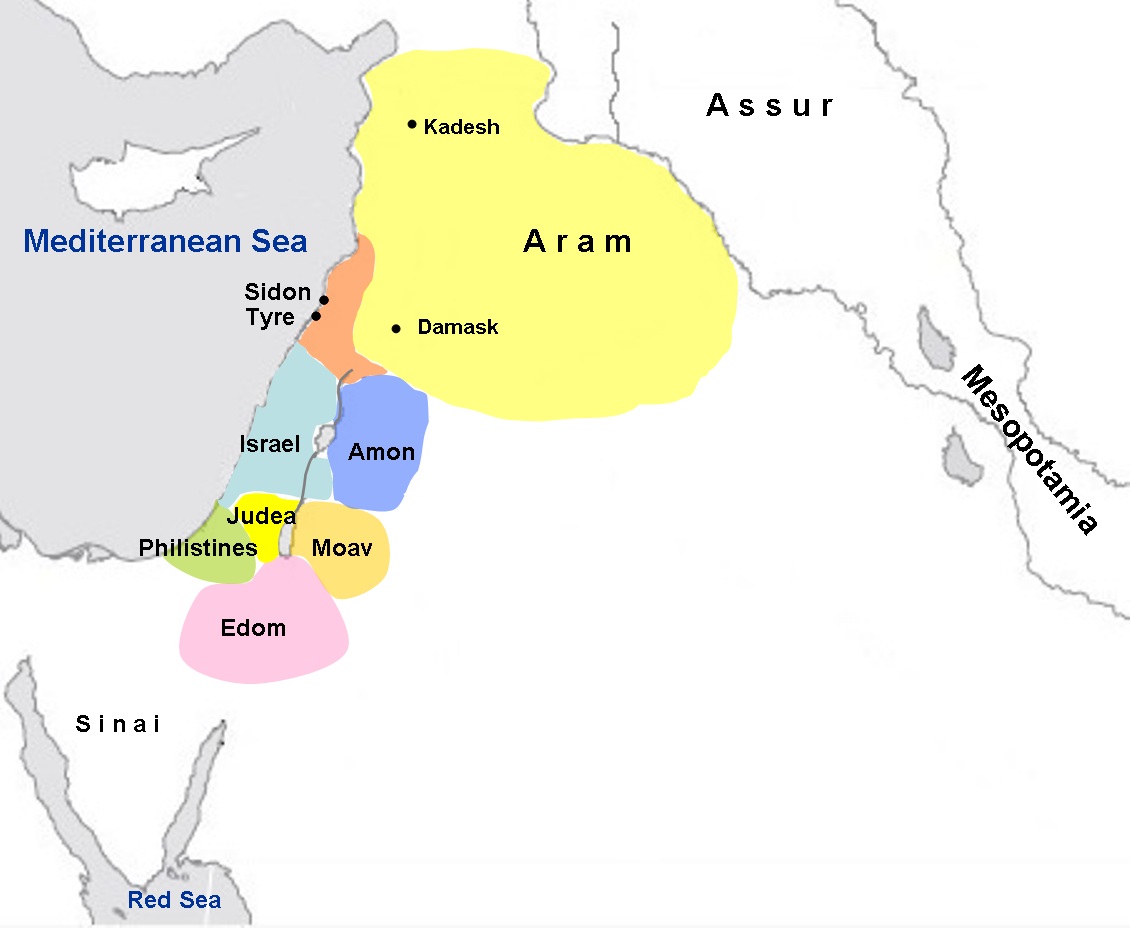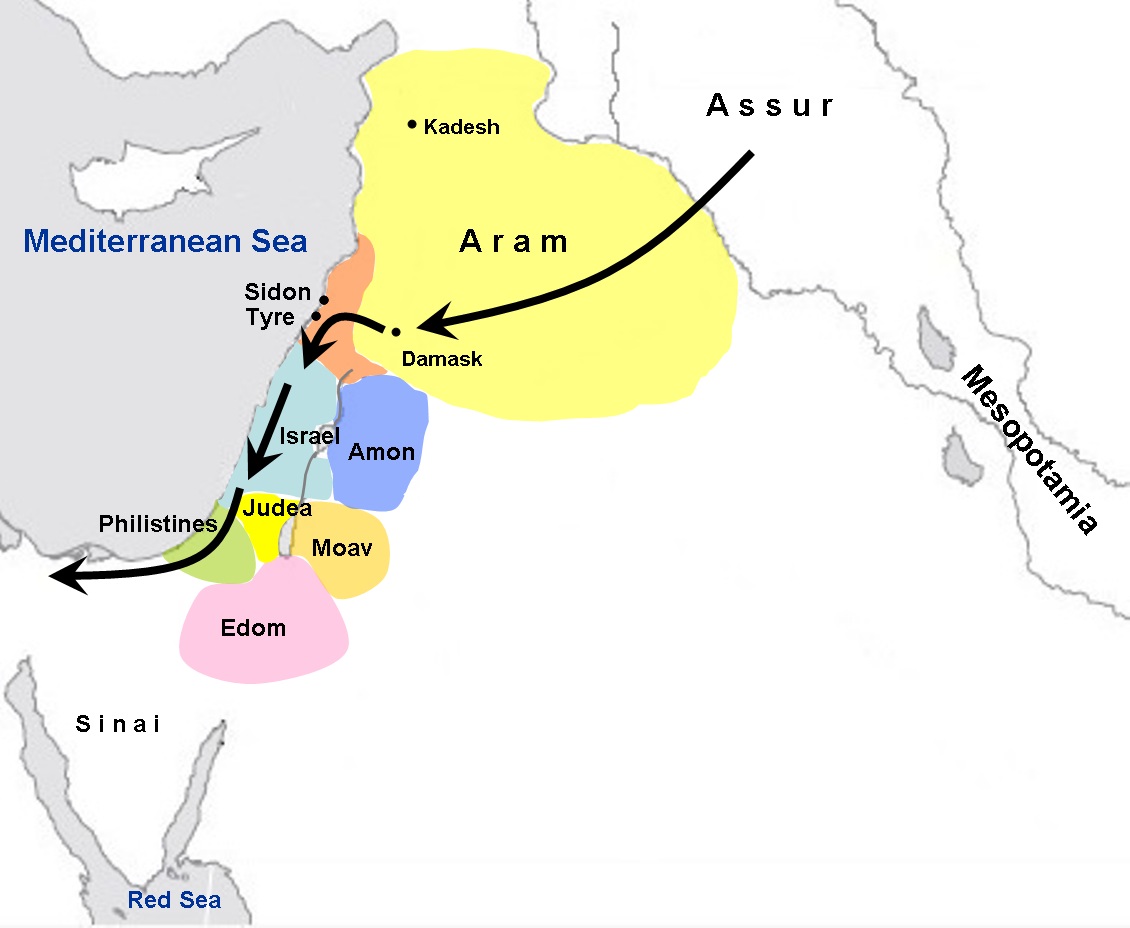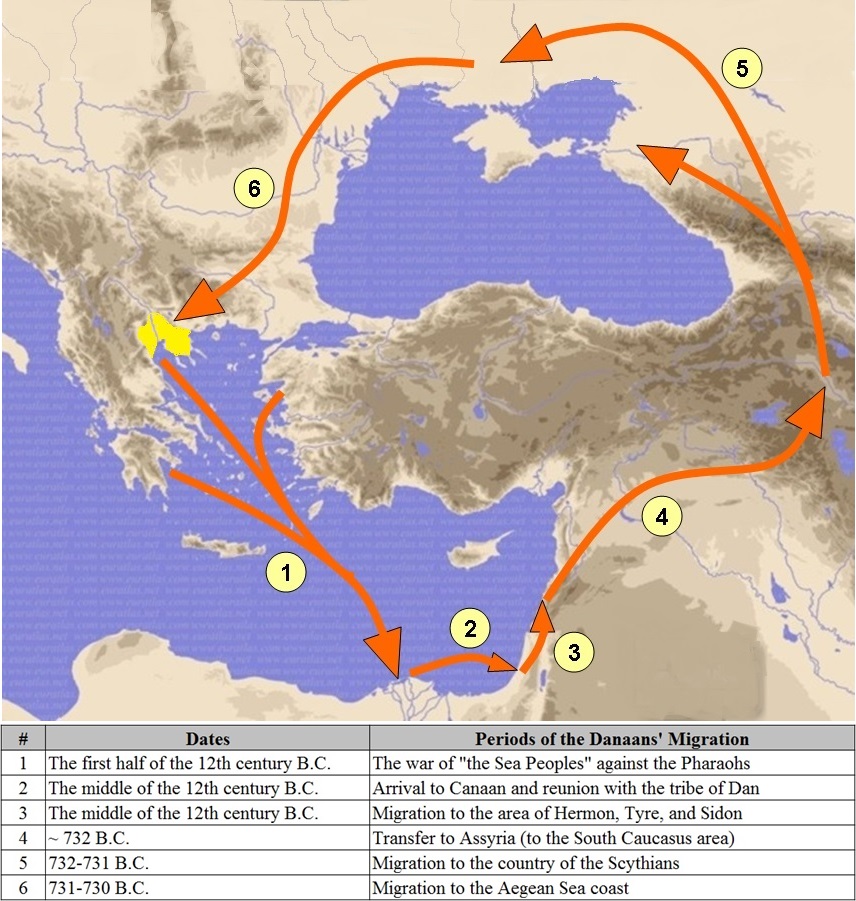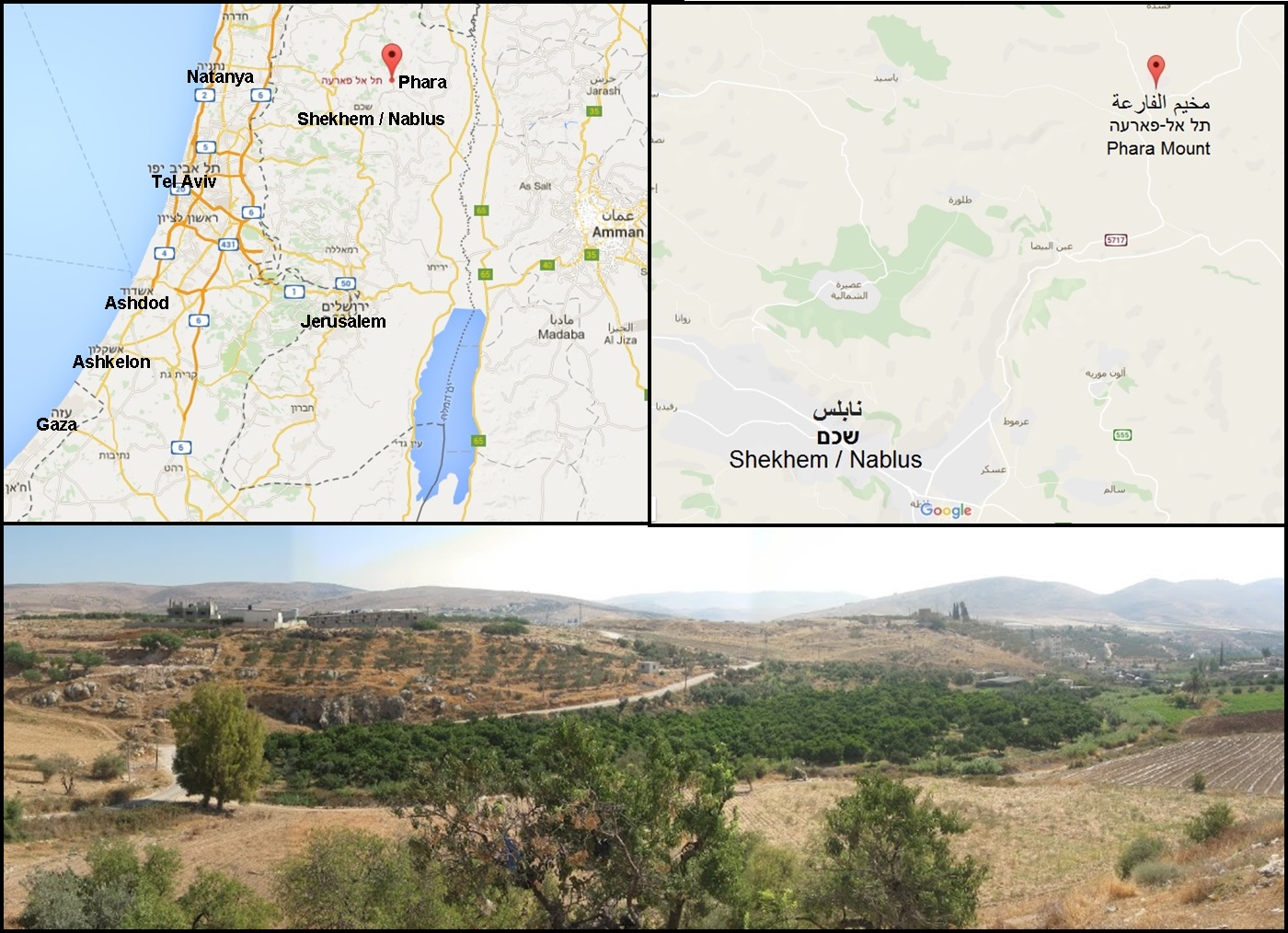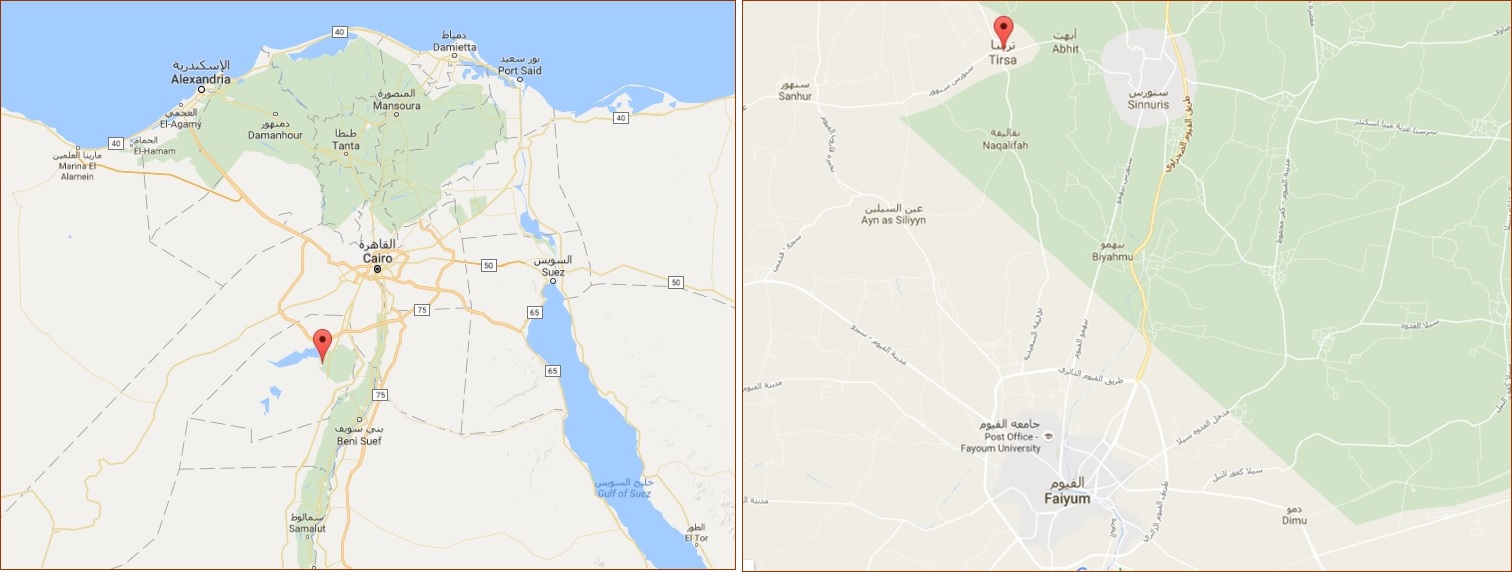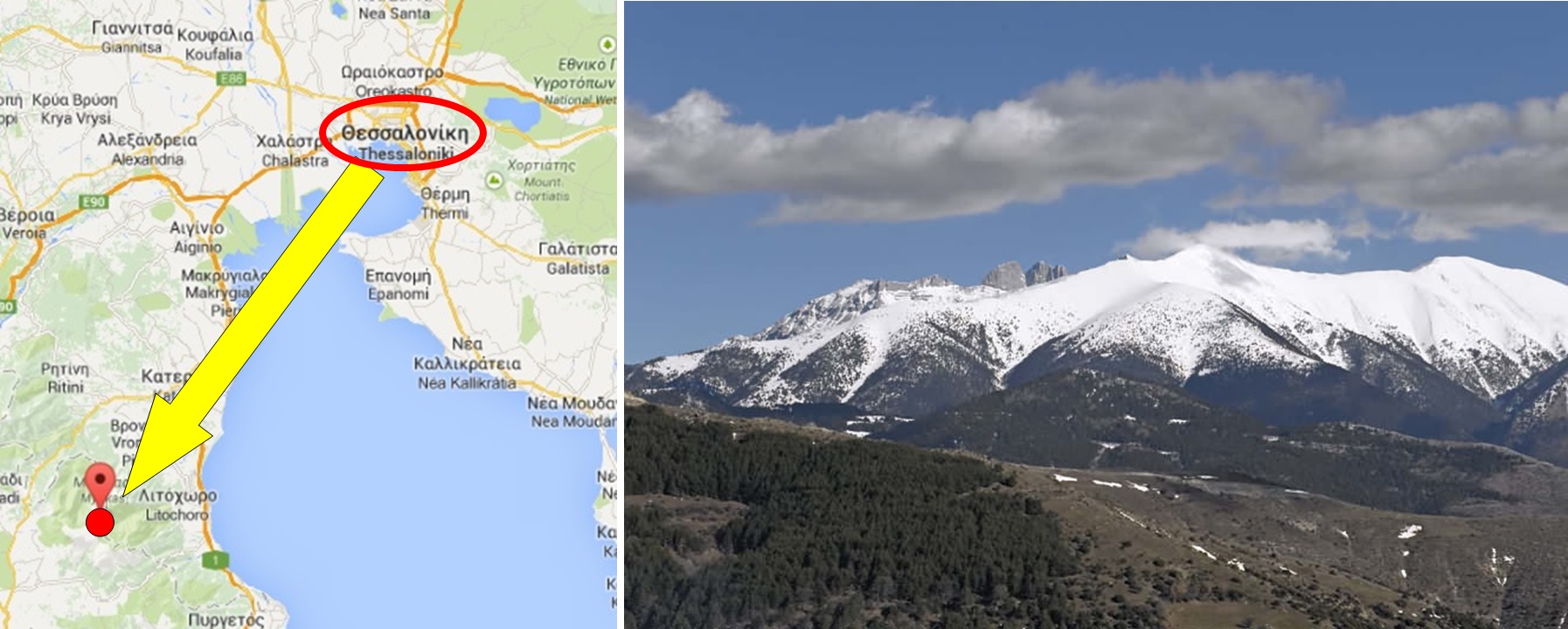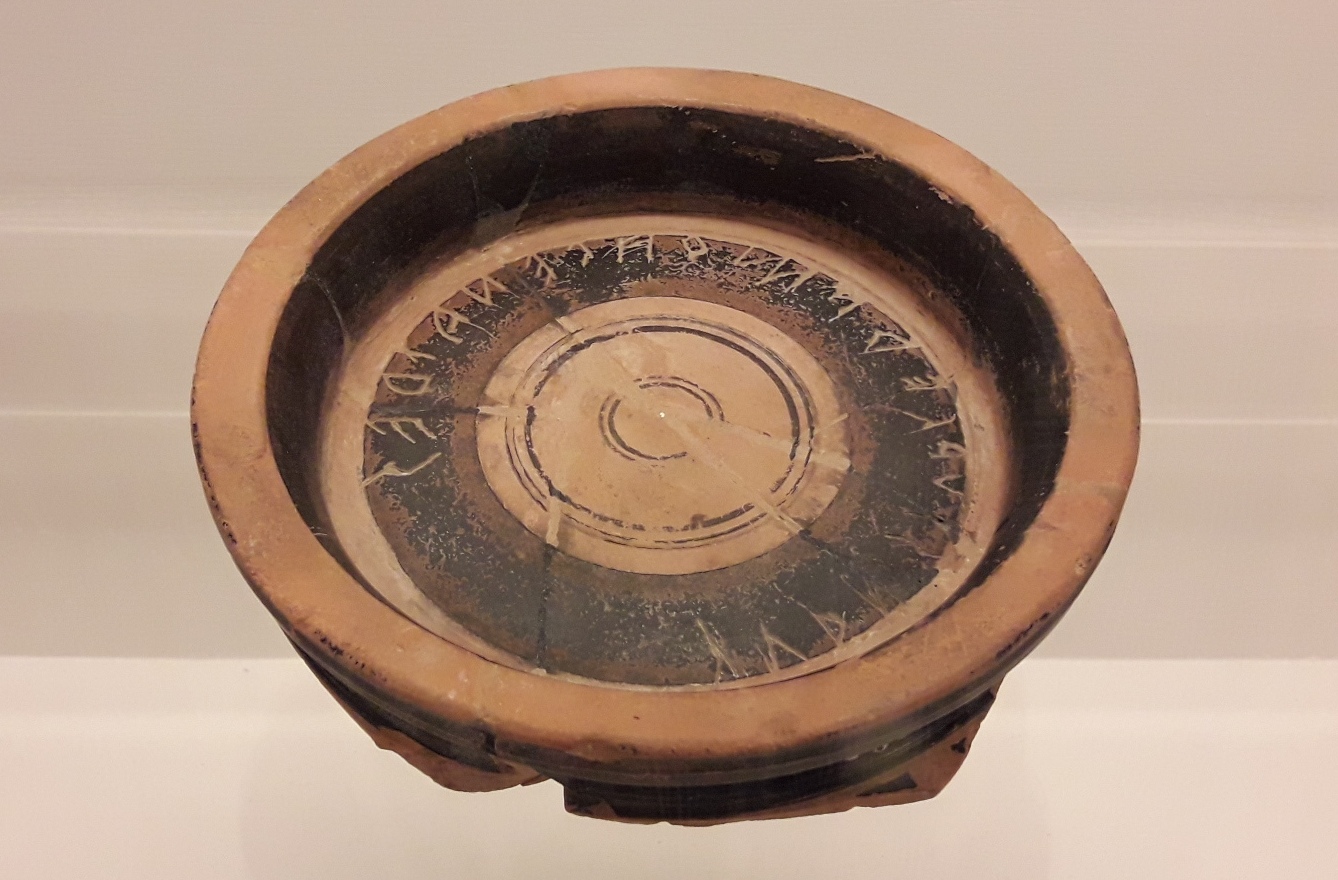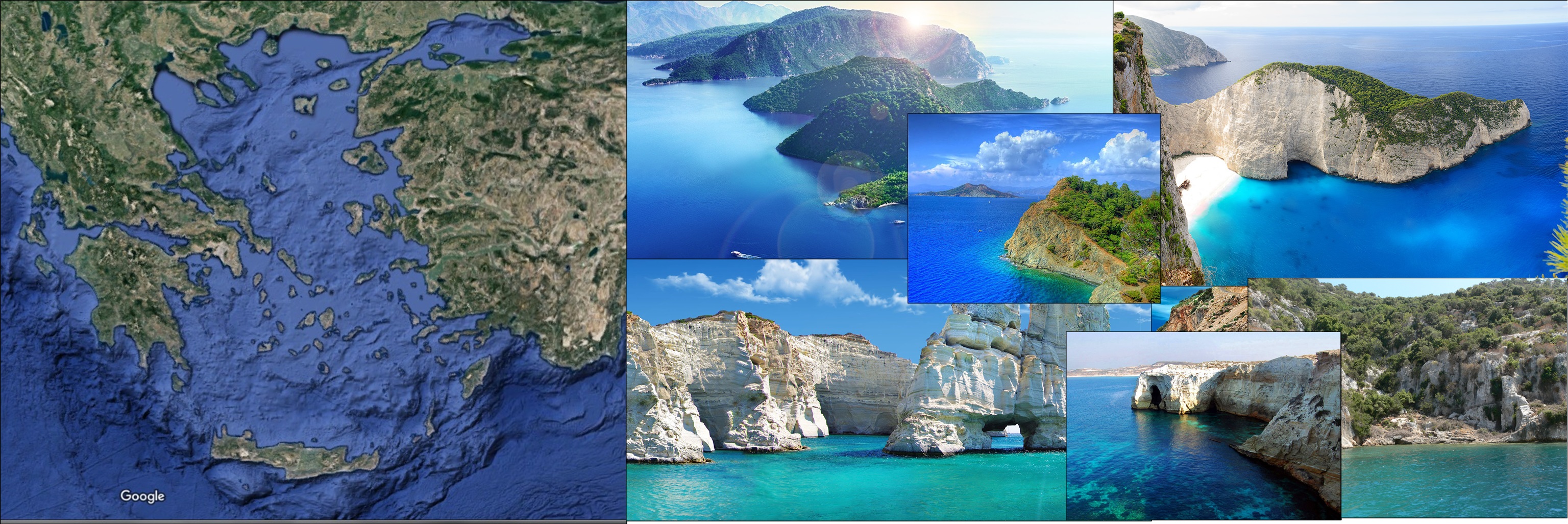Where 10 tribes disappeared, and how the Ancient Greek civilization appeared.
.
BRIEFLY ABOUT THE PAST
Between the 15th and 14th centuries B.C., due to natural processes, part of the Jewish population in Egypt emigrated to the coast and to the islands of the Mediterranean (See the article “Exodus: Behind the Scenes“). In the 13th century B.C., in the reign of Pharaoh Ramesses II, i.e. during the period, which is usually identified with the Egyptian slavery described in the Torah, the emigration became a mass phenomenon – tens, and possibly hundreds of thousands of Jews left Egypt. It should be noted that refugees were people standing out in the crowd for their initiative and love of freedom. Most of them settled in the Aegean Sea region. In historical literature they have been called as follows:
- The Danaans – the Jews from the Tribe of Dan who founded the city (Heb) מיקנה [mikne] = (Eng) herd → Mycenae. In the Egyptian inscriptions they are mentioned as “danan”.
- The Achaeans – the Jews from different tribes who settled in the Aegean Sea region, as well as in other regions of the Mediterranean. Achaeans is their common name, which came from the word (Heb) אח [akh] = (Eng) brother. Groups of Achaeans settled in different places called themselves in different ways:
- (Heb) שרדן [sardan] = (Eng) surviving → hence the name of the island of Sardinia
- (Heb) לך [lekh] = (Eng) walking, leaving
- (Heb) סקל [sakal] = (Eng) throwing stones
- In total, the names of 11 groups of Achaeans are mentioned in Egyptian, Ugaritic, and other documents.
Below is the map showing directions in which the Danaans and the Achaeans used to settle:
PICTURE 01
The Danaans founded many settlements in the east direction towards Asia Minor, conducted an alliance with the Hittites, and in the beginning of the 13th century B.C. fought with Pharaoh Ramesses II in the battle, known in history as “The Battle of Kadesh”.
PICTURE 02
The results of the Battle of Kadesh were the following:
- Pharaoh Ramesses II returned to Egypt and revenged his defeat on the Jews of Egypt – thus, it was the beginning of the period of slavery in the history of the Jews of Egypt (Read more about it in the article “And They Made Their Lives Bitter“).
- The Danaans moved forward to the south-east and founded the state of Aram with the capital in Damascus.
PICTURE 03
In 1194 B.C. Jews begin the Exodus from Egypt to Sinai (See the article “Chronology of the Fathers“).
PICTURE 04
During 40 years, which the Jews stayed in the Sinai desert, they acquired the greatest instrument for spreading information, i.e. total literacy on the basis of the phonetic alphabet consisted of 22 letters (See the article “Why does Europa write left-to-right?“). They also acquired the basic moral principles stated in the Ten Commandments (See the article “About the Nature of Lows and the Lows of Nature“).
During all 40 years of the Exodus, Pharaohs of Egypt were not chasing their slaves staying in Sinai at a distance of arm’s length.
WHY?
The answer: The Jewish Diaspora of the Mediterranean attacked the coasts of Egypt in order to draw attention of the Pharaoh’s army and to prevent the chase of the Jews during the Exodus. In the Egyptian chronicles, as well as in modern literature, this operation has been called as “the War of the Sea Peoples.”
PICTURE 05
This war stopped with the end of the Exodus and invasion of the Jews to Canaan from Sinai. The Danaans and the Achaeans did not return to the Aegean Sea region; they went to the east, to Canaan to join the rest of the people.
PICTURE 06
Thus, the Jews of Egypt and the Jews of Diaspora left Egypt and the Aegean Sea region at the same time and gathered in the Promised Land. This happened in the middle of the 12th century B.C. (read the article “Chronology of the Fathers“).
Small part of the Jewish population remained on the northern coast of the Aegean Sea, mainly in the territory called (Heb) מוקדון [mokdon] = (Eng) focus, concentration – today it is Macedonia region of Greece. The rest area of the Aegean Sea region became empty for 420 years, which are called in literature as the Dark Ages of Greece. The archaeologists found on this territory NO evidence of human activity for the period from the middle of the 12th century B.C. till the end of the 8th century B.C. In other words, the archaeological levels of that period do not exist at all. Also we don’t have any literature evidence of that period. Only in 730 B.C., approximately, the descendants of the Danaans, who had been deported from the territory of modern Lebanon by the Assyrian king Tiglath-Pileser III, returned to the Aegean Sea region and caused a cultural and technological “explosion” that would give birth to Ancient Greece.
This article describes the sequence of events, after which the Ancient Greek civilization appeared.
-
REUNION
Before the invasion of the Jews Canaan was surrounded by peoples kindred to the Jews:
- In the north was the state of Aram founded by the Jewish emigrants from Egypt (See the article “And They Made Their Lives Bitter“).
- In the east were the Ammonites – the descendants of Ben Ammi, the son of Lot, the nephew of Abraham, the forefather.
- In the south-east were the Moabites – the descendants of Moab, the son of Lot, the nephew of Abraham, the forefather.
- In the south were the Edomites – the descendants of Esau, the brother of Yaakov, the forefather, the grandson of Abraham, the forefather.
- In the south-west were the Philistines. Abraham, the forefather, had made a treaty of friendship with their king Abimelech about 650 years before the described events (See below.).
PICTURE 07
In the middle of the 12th century B.C., the Tribes of Israel under the leadership of Yehoshua bin Nun (Joshua) settled in the land of Canaan. Then they were joined by “the Sea Peoples” – the Danaans and the Achaeans:
- The Danaans landed in the territory of modern Tel Aviv with the intention to join their kindred from the Tribe of Dan. This area is today known as Gush Dan.
- The Achaeans settled along the coast of the Mediterranean, to the south of Gush Dan, and mixed with the Philistines.
PICTURE 08
.
WHO ARE THE PHILISTINES?
The word “Philistines” entered English from Hebrew through Greek:
(Heb) פלישתים [plishtim] → (Greek) Φιλισταίοι [philistayo] → (Eng) Philistines
The Philistines were the people who dwelt in the south of Canaan even before the arrival of the forefather Abraham (read the article “Who are you, Pharaoh?“). Those people had Semitic names and spoke a language close to Hebrew; therefore, they should be considered as the Semitic people, and not the strangers from the islands of the Mediterranean, as it is written here and there in literature.
Here is the passage from the Torah, providing the evidence of the treaty between Abraham, the forefather, and Abimelech, the king of the Philistines, concluded in the 19th century B.C., 610 years before the beginning of the Exodus:
תורה, ספר בראשית
כא,כז וַיִּקַּח אַבְרָהָם צֹאן וּבָקָר, וַיִּתֵּן לַאֲבִימֶלֶךְ; וַיִּכְרְתוּ שְׁנֵיהֶם, בְּרִית. כא,כח וַיַּצֵּב אַבְרָהָם, אֶת-שֶׁבַע כִּבְשֹׂת הַצֹּאן–לְבַדְּהֶן. כא,כט וַיֹּאמֶר אֲבִימֶלֶךְ, אֶל-אַבְרָהָם: מָה הֵנָּה, שֶׁבַע כְּבָשֹׂת הָאֵלֶּה, אֲשֶׁר הִצַּבְתָּ, לְבַדָּנָה. כא,ל וַיֹּאמֶר–כִּי אֶת-שֶׁבַע כְּבָשֹׂת, תִּקַּח מִיָּדִי: בַּעֲבוּר תִּהְיֶה-לִּי לְעֵדָה, כִּי חָפַרְתִּי אֶת-הַבְּאֵר הַזֹּאת. כא,לא עַל-כֵּן, קָרָא לַמָּקוֹם הַהוּא–בְּאֵר שָׁבַע: כִּי שָׁם נִשְׁבְּעוּ, שְׁנֵיהֶם. כא,לב וַיִּכְרְתוּ בְרִית, בִּבְאֵר שָׁבַע; וַיָּקָם אֲבִימֶלֶךְ, וּפִיכֹל שַׂר-צְבָאוֹ, וַיָּשֻׁבוּ, אֶל-אֶרֶץ פְּלִשְׁתִּים. כא,לג וַיִּטַּע אֶשֶׁל, בִּבְאֵר שָׁבַע; וַיִּקְרָא-שָׁם–בְּשֵׁם יְהוָה, אֵל עוֹלָם. כא,לד וַיָּגָר אַבְרָהָם בְּאֶרֶץ פְּלִשְׁתִּים, יָמִים רַבִּים
Torah, book Genesis
21,27 And Avraham took sheep and oxen, and gave them unto Avimelech; and they two made a covenant. 21,28 And Avraham set seven ewe-lambs of the flock by themselves. 21,29 And Avimelech said unto Avraham: ‘What mean these seven ewe-lambs which thou hast set by themselves?’ 21,30 And he said: ‘Verily, these seven ewe-lambs shalt thou take of my hand, that it may be a witness unto me, that I have digged this well.’ 21,31 Wherefore that place was called Beer Sheva; because there they swore both of them. 21,32 So they made a covenant at Beer-sheva; and Avimelech rose up, and Phicol the captain of his host, and they returned into the land of the Philistines. 21,33 And Avraham planted a tamarisk-tree in Beer Sheva, and called there on the name of the LORD, the Everlasting God. 21,34 And Avraham sojourned in the land of the Philistines many days.
Nowadays, on the place where it all happened, there is the city of (Heb) באר שבע [beer sheva] = (Eng) well of oath, → (Greek) Βηρσαβεέ [birsabee] → (Eng) Beer Sheba.
And here is an extract from the Books of the Prophets, describing the places where the Philistines were living in the12th century B.C.:
נביאים, ספר יהושע
יג,ג מִן-הַשִּׁיחוֹר אֲשֶׁר עַל-פְּנֵי מִצְרַיִם, וְעַד גְּבוּל עֶקְרוֹן צָפוֹנָה–לַכְּנַעֲנִי, תֵּחָשֵׁב; חֲמֵשֶׁת סַרְנֵי פְלִשְׁתִּים, הָעַזָּתִי וְהָאַשְׁדּוֹדִי הָאֶשְׁקְלוֹנִי הַגִּתִּי, וְהָעֶקְרוֹנִי, וְהָעַוִּים
Bible (King James)/Joshua, chapter 13, verse 3
From Shihor, which is before Egypt, even unto the borders of Ekron northward, which is counted to the Canaanite: five domains of the philistines: Gaza and Ashdod, Eshkelon, Gat and Ekron, also the Avim.
The cities Gaza, Ashkelon, and Ashdod still exist nowadays, and as for the places (Heb) תל מיקנה [tel mikne], where the city of Ekron was located, and (Heb) תל צופית [tel tzofit], where the city of Gath was located, they are also well known (See the article “Where is Hercules buried?“).
In this verse, the place Shihor is mentioned. Probably refers to Sheruhan, which is written about in the article “Who are you, Pharaoh?“
Here is a modern map, which shows the territory where the Philistines lived after the Jews had settled in Canaan:
PICTURE 09
.
THE NEW PHILISTINES
The Achaeans entered the coast of Canaan with the goal to unite with the other Jews, but the reunion failed according to the following reasons:
- The Jews, with their 40-year “school” of Moses in Sinai, entered Canaan as one people, with reading and writing skills, united by belief in One God, by common morality principles based on The 10 Commandments, and by pyramidal logistics of management.
- The Achaeans were pagans, absolutely illiterate and not able to live under the laws of society united by common ideology and morality.
The Achaeans failed to assimilate with the Jews, but they quickly found a common language with the Philistines, who were also the pagans. Thus, a new community of people appeared, i.e. a mixture of the Achaeans and the Philistines. These NEW Philistines, as a nation, existed for 5.5 centuries, till 604 B.C., when the king of Babylon Nebuchadnezzar II conquered the philistine cities and deported the population, which would never come back.
739 years later from the word Philistines the word Palestine appeared – the Romans gave this name to Judea after the defeat of Bar Kokhba’s revolt in 135. The Romans purposely renamed the Roman province of Judea to the Roman province of Palestine, as they wanted to erase the name of Judea from the memory of the peoples. This tendency is also supported by some circles nowadays. Below is a map that has been published in the Internet by one of the European public organizations.
PICTURE 10
.
MIGRATION OF THE DANAANS TO THE NORTH
Reunion of the Danaans to the tribe of Dan failed for the same contradictions. In order not to make the contradictions deeper, the leaders of the tribe of Dan decided to move the Danaans to another area.
Where to?
Let us remember where they were from. They were from the city of Mycenae. Those were their relatives who participated in the Battle of Kadesh and founded the state of Aram with the capital in Damascus a little over 120 years ago.
The Danaans migrated to the north. They settled in the territories close to Aram, i.e. in the Golan Heights, in the Mount Hermon surroundings, and on the coast of modern Lebanon. The Dan settlement and the Dan River, named so in honor of the Danians in those days, still exist at the foot of Mount Hermon.
PICTURE 11
On the coast of Lebanon, the Danaans settled in the already existing Aramaic cities, such as (Aramaic) צור [tsor] = a rock → (Eng) Tyre and (Aramaic) צידון [tsidon] = upper → (Eng) Sidon, and became part of the population of Aram, but as for administration, Tyre and Sidon were always “free cities”, independent of the central Aramaic government.
Despite the separation from the tribe of Dan, the Danaans always remembered their roots and family connections with this tribe. Here is a quote from the letter of Huram, the king of Tyre, to King Solomon, written about 200 years later, in the middle of the 10th century B.C., in which Huram emphasizes the existence of family connections with the tribe of Dan:
תנ”ך, דברי הימים
ב ב,יא וַיֹּאמֶר, חוּרָם–בָּרוּךְ יְהוָה אֱלֹהֵי יִשְׂרָאֵל, אֲשֶׁר עָשָׂה אֶת-הַשָּׁמַיִם וְאֶת-הָאָרֶץ: אֲשֶׁר נָתַן לְדָוִיד הַמֶּלֶךְ בֵּן חָכָם, יוֹדֵעַ שֵׂכֶל וּבִינָה, אֲשֶׁר יִבְנֶה-בַּיִת לַיהוָה, וּבַיִת לְמַלְכוּתוֹ. ב ב,יב וְעַתָּה, שָׁלַחְתִּי אִישׁ-חָכָם יוֹדֵעַ בִּינָה–לְחוּרָם אָבִי. ב ב,יג בֶּן-אִשָּׁה מִן-בְּנוֹת דָּן, וְאָבִיו אִישׁ-צֹרִי יוֹדֵעַ לַעֲשׂוֹת בַּזָּהָב-וּבַכֶּסֶף בַּנְּחֹשֶׁת בַּבַּרְזֶל בָּאֲבָנִים וּבָעֵצִים בָּאַרְגָּמָן בַּתְּכֵלֶת וּבַבּוּץ וּבַכַּרְמִיל, וּלְפַתֵּחַ כָּל-פִּתּוּחַ, וְלַחְשֹׁב כָּל-מַחֲשָׁבֶת–אֲשֶׁר יִנָּתֶן-לוֹ, עִם-חֲכָמֶיךָ, וְחַכְמֵי, אֲדֹנִי דָּוִיד אָבִיךָ
Bible, 2 Chronicles, Chapter 2
12 Huram continued, “Blessed be Yahweh, the God of Israel, that made heaven and earth, who has given to David the king a wise son, endowed with discretion and understanding, that should build a house for Yahweh, and a house for his kingdom. 13 Now I have sent a skillful man, endowed with understanding, of Huram my father’s, 14 the son of a woman of the daughters of Dan; and his father was a man of Tyre, skillful to work in gold, and in silver, in brass, in iron, in stone, and in timber, in purple, in blue, and in fine linen, and in crimson, also to engrave any manner of engraving, and to devise any device; that there may be a place appointed to him with your skillful men, and with the skillful men of my lord David your father.
.
CULTURAL AND BUSINESS RISE
Those guys were really well up in international trade. They settled in such a place, where the main trade route, which connected Mesopotamia and Egypt, came close to the Mediterranean coast.
PICTURE 12
They also brought to Tyre and Sidon their experience in ship-building and knowledge of navigation in the Mediterranean.
In the 9th and 10th centuries B.C., the merchants from Tyre and Sidon founded many colonies on the Mediterranean coast, including (Heb) קרת חדשה [keret khadasha] = (Eng) The New City, which became their biggest outpost during the exploration of the western Mediterranean.
(Heb) קרת חדשה [keret khadasha] → (Greek) Καρθαγένη [kartageon] → (Lat) Carthage → (Eng) Carthage
PICTURE 13
After a short period of time, Tyre, Sidon, and Carthage made up a federation controlling practically the whole seaborne trade of that time. Below is a list (not complete!) of the most known colonies founded by them:
PICTURE 14
.
RELIGION
When King (Heb) שלמה [shlomo] → (Eng) Solomon died, his son (Heb) רחבעם [rehavaam] → (Eng) Rehoboam succeeded him to the throne. As a result of unwise behavior of King Rehoboam, the unified kingdom ceased to exist, and two new kingdoms appeared instead: the kingdom of Israel, which united 10 tribes, and the kingdom of Judea, which united two tribes. The kingdom of Aram, as well as the cities of Sidon and Tyre became independent.
Religious leaders took the side of King Rehoboam and gathered in Judea.
PICTURE 15
Thus, the territory settled by the Jews was divided into 3 parts:
- The north: the Jews, who were pagans, lived in the kingdom of Aram, and in Sidon and Tyre.
- The south: the Jews, who were monotheists, lived in the kingdom of Judea.
- The center: the Jews of the kingdom of Israel, who were under cultural and religious influence of the north and south.
Such a situation lasted for about 150 years (till the end of the 8th century B.C.). During that time the pagan deities of Tyre and Sidon got human look and human character. Communication with neighboring Israel changed them to the gods bearing morality, and thus put them head and shoulders above pagan deities of other peoples. However, as people used to say in Odessa, morality and morality are two big differences. Every nation has such a morality that combines with its mentality; and the mentality of the Danaans still remained pagan.
The Danaans and the Jews had good relations. The relations were so good that (Heb) אחאב [ahav] (871 – 852 B.C.), the king of the Kingdom of Israel, married (Heb) איזבל [jezebel or isabel], the daughter of the king of Sidon. The First Book of Kings contains a story describing how Jezebel propagated by force her own pagan religion among the Israelites, built pagan altars on the tops of the mountains in Samaria, and persecuted the prophets. She largely succeeded in her activity. Many Israelites lost their faith in one Eternal God, therefore connections between people and the tribes were broken, and as a result, the Jews were fatally defeated in the war with the Assyrian king Tiglath-Pileser 3 in the end of the 8th century B.C., but we’ll talk about that below.
.
LITERACY
The Jews, who left Egypt and settled on the coasts of the Mediterranean between the 16th and 13th centuries B.C., spoke an archaic dialect of the Hebrew language. In the beginning of the 13th century B.C., they founded the state of Aram, and from that time this dialect has been called the Aramaic language – (Heb) ארמית [aramit].
This group of the Jews could not write. Although in the 14th century B.C. the Jews already had a primitive phonetic alphabet (the so-called linear script), this alphabet, which consisted of up to 80 characters, was still too complicated and, therefore, could not be used by the majority of the population. That is why it was not developed further and disappeared in the 13th century B.C.
At the same period of time, the Jews who were living in Egypt continued improving their language and alphabet. In the beginning of the Exodus they spoke Hebrew that could be understood by the modern Israeli, and their alphabet was completed and consisted of the same 22 letters as the modern one (Read the article “Why does Europa write left-to-right?“), but the shape of the letters was different.
The Ten Commandments were written on the Tables of the Law in 1194 BC. with the letters of the ancient Hebrew alphabet (look here).
While communicating with the Israelites, the Arameans learned the Hebrew letters. They used this alphabet to make notes about trade operations with partners from different countries, as the phonetic alphabet allowed (and allows) writing down the words spoken in any language.
Between the 11th and 8th centuries B.C., the kingdom of Aram was the center of the world commerce. The Aramaic merchants made the Aramaic language (and the Hebrew alphabet, respectively) a language of international communications, which remained in this status in the Eastern countries until Alexander the Great came, i.e. till the end of the 4th century B.C.
The ancient font of the Hebrew alphabet is here and there called as Phoenician. This is not correct because the word “Phenicia”, as a geographical name, appeared about 700 years after the formation of this font had been completed – this will be discussed below.
To the 6th century B.C., new fonts had been created in Aram and Mesopotamia, one of which represented the so-called square font. The Jews, who returned from the Babylonian captivity in 538 B.C, brought with them that square font to Judea, which over time (and up to now) replaced the original font. The last usage of the ancient Jewish font was recorded in 135, on Bar Kochba’s coins.
Let’s compare the ancient (above) and square (below) fonts.
-
STATEHOOD
As mentioned above, the Danaans had settled in a big territory including modern Lebanon and northern parts of modern Israel as well. They lived on this territory for about 420 years (approximately between 1153 and 732 B.C). The kings of Tyre and Sidon were mentioned in written sources of that time, but there is no evidence that a state with one central authority has ever existed. Here and there in literature the area where the Danaans lived is called as Phoenicia, but such a state never existed. How the word Phoenicia appeared and what it means will be told below.
.
THE DANAANS WERE THE FIRST TO BEAR THE BRUNT OF THE WAR
Between 740 and 735 B.C., the Assyrian king Tiglath-Pileser III began the war against Rezin, the king of Aram, and his allies, with the king of Israel Pekah among them. In 732 B.C. the Assyrian army came from the north and started little by little taking the lands settled by the Israelites. The war lasted for 31 years.
PICTURE 17
Tyre and Sidon were the first to bear the brunt of the war, as their land was the northernmost.
By defeating the Danaans, Tiglath-Pileser 3 killed two birds with one stone:
- He moved several tens of thousands of people with the best city-life experience of that time from Tyre and Sidon to the areas, located to the south of the Caucasus (modern Turkish Armenia and Kurdistan). Thus he solved the problem of economic development for empty regions of his country.
- The fertile and developed land, which had become free, he gave to his soldiers, thus annexing this territory to his empire and making it impossible for the deported people to come back home.
The proximity of the sacred mountain of Ararat did not impress the exiles of Tire and Sidon, as they did not take a great interest in reading the Torah. They did not live in that area for a long time. They continued migrating to the north and, after crossing the Caucasus, arrived to the territories settled by the Scythians. And good trade relations with the Scythians had already been established 600 years before the described events – the Golden Fleece myth.
Some of the migrants settled in the country of the Scythians, and the other ones continued migrating to the south-west, to the coast of the Aegean Sea.
Thus, in the end of the 8th century B.C., the Danaans, who had left the coast of the Aegean Sea in the middle of the 12th century B.C. during the war of “The Sea Peoples”, closed the circle by joining their relatives, who had been living during all these centuries in (Heb) מוקדון [mokdon] – the territory of future Macedonia,.
Here is a complete description of the Danaans’ route:
PICTURE 19
.
THE END OF THE DARK AGES IN GREECE
While the Danaans were travelling around the Black Sea, there was a war fought in the territory of the Kingdom of Israel. A strange war! The distance between Sidon and Jerusalem was only 200 km. Why didn’t Tiglath-Pileser III finish this war within a month or three? Why did this war last for 31 years?!
Tiglath-Pileser III realized during the war that the Israel tribes were separated and not helping each other. He decided to conquer the territory with small losses, and his successors reached the goal to 701 B.C.
The population of the Kingdom of Israel, which probably consisted of more than 3 million people (See the article “Numbers“), could not join together to defend their country and the result was as follows:
- About 50 thousand or more people were deported to different areas of Assyria.
- About one third of the population escaped to the south. Part of them settled in Judea (about 100 thousand settled in Jerusalem and in its vicinity). Some of the Jews continued migrating to Egypt, where they settled together with the descendants of those Jews who had remained in Egypt, in the land of Faiyum (in the land of Goshen), from the time of the Exodus (See the article “Exodus: Behind the Scenes“). Some of them continued up the Nile and settled on Elephantine Island (read the article “Ev and Kiev – history repeats itself“)
- About one third chose to move by sea to the colonies founded here and there in the Mediterranean Sea. The lion’s share of them settled in the islands of the Aegean Sea, because they were closer to Israel in comparison with the other parts of the Mediterranean.
- The others, mixed with the Assyrian pagans from the city of (Heb) כותה [kuta] and other areas of Assyria, became the ancestors of a new ethnology-cultural group, i.e. the Samaritans.
It is clear from the stated above that the end of the 8th century B.C. was notable for two groups of newcomers, which arrived to Greece: at first, relatively small group of the Danaans, who had passed through the Northern Black Sea Lowland, settled by the Scythians; and secondly, the masses of the Israelites who had escaped from the invasion of the Assyrians by sea and in other ways.
PICTURE 20
A stream of newcomers filled the islands and the coast of the Aegean Sea. They brought with them textiles processing and dye manufacturing technologies, and, which was the most important, a universal technology of long-term storage and transmission of information – the phonetic alphabet (See the article “Why does Europa write left-to-right?“). The land, which had become empty 420 years ago, was again full of life – that was the end of the Dark Ages in Greece.
Different groups of people with common roots (the Mocdonians, the Danaans, and the Israelites) joined together, and this led to an unprecedented burst of emotions. A lot of saved memories, legends, and parables appeared again. Exactly in this period of time, Homer, who became legendary, wrote his epics the “Odyssey” and the “Iliad”, which have been the only (!!!) sources of our knowledge about the events that happened in Greece between the 13th and the 12th centuries B.C., i.e. 600 years before Homer was born.
Why didn’t the idea of describing those events come to any other “Homer’s” mind during 600 years mentioned? The answer is very simple: the Jews of Mocdon, who had been keeping this information, just did not know how to write. These epics, the “Odyssey” and the “Iliad”, were direct consequences of importing writing skills from Israel to Mocdon.
By the way, about Homer: Homer’s father was from the descendants of the Achaeans, which had been living in Mocdon, and his mother was from the descendants of the Danaans, which had arrived to Mocdon through Scythia. Homer got his name from the Torah in honor of Gomer, the son of Japheth, and the grandson of Noah:
תורה, ספר בראשית
י,א וְאֵלֶּה תּוֹלְדֹת בְּנֵי-נֹחַ, שֵׁם חָם וָיָפֶת; וַיִּוָּלְדוּ לָהֶם בָּנִים, אַחַר הַמַּבּוּל. י,ב בְּנֵי יֶפֶת–גֹּמֶר וּמָגוֹג, וּמָדַי וְיָוָן וְתֻבָל; וּמֶשֶׁךְ, וְתִירָס. י,ג וּבְנֵי, גֹּמֶר–אַשְׁכְּנַז וְרִיפַת, וְתֹגַרְמָה. י,ד וּבְנֵי יָוָן, אֱלִישָׁה וְתַרְשִׁישׁ, כִּתִּים, וְדֹדָנִים
Torah, book Genesis
10,1 Now these are the generations of the sons of Noah: Shem, Ham, and Japheth; and unto them were sons born after the flood. 10,2 The sons of Japheth: Gomer, and Magog, and Madai, and Javan, and Tubal, and Meshech, and Tiras. 10,3 And the sons of Gomer: Ashkenaz, and Riphath, and Togarmah. 10,4 And the sons of Javan: Elishah, and Tarshish, Kittim, and Dodanim.
Homer was born in the city of Therma.
.
TIRSA WAS THE ANCIENT CAPITAL OF THE KINGDOM OF ISRAEL
Let’s go about 250 years back into the past, to the 10th century B.C.
The city of (Heb) תרצה [Tirsa] was situated 11 km north-east of the city of Shechem and had three special features:
- For about 50 years in the 9th century B.C. it was the capital of the Kingdom of Israel.
- It was the only city in Israel with a female name.
- It was the first city in the world, which had been built under the project, i.e. according to preliminary design.
The place where the city was situated is today called as follows:
(Heb) אל-פארעה תל [Tell el-Farah] = (Arab) مخيم الفارعة [mahaim el-farah] = (Eng) Phara Mount.
We will return to the name of this place in the end of this article.
PICTURE 21
The city of Tirsa, with an area of about 200,000 sq. m., was situated on the hill and surrounded by small streams from three sides. All the houses were of rectangular shape, and all the streets formed a rectangular net. All the streets went down to the streams. A gutter was made along every street to collect waste water. Thus, it was the first city in the world with a sewage system.
We can assume that the city of Tirsa really made a big impression and was a standard of beauty for its contemporaries. King David made a compliment to his wife in the “Song of Songs” in the following way:
You are fair as Tirsa, my beloved = יָפָה אַתְּ רַעְיָתִי כְּתִרְצָה
The Israelites that came to Egypt escaping from the invasion of Tiglath-Pileser 3 brought with them, among other things, the name of Tirsa. And even nowadays, 10 km away to the north of the city of Faiyum, there is a settlement with such a name (Arab) ترسه [tirsa].
PICTURE 22
.
THERMA AS THE BIRTHPLACE OF THE ANCIENT GREEK CULTURE
The settlement of (Heb) תרמה [therma] = (Greek) Θέρμα = (Eng) Therma was founded by people of Mocdon
Between the 13th and the 8th centuries B.C. on the shore of a great gulf of the Aegean Sea was founded a small settlement by people of Mocdon.
PICTURE 23
When the Danaans arrived there in the end of the 8th century B.C., the settlement turned into a city, which would be playing a leading role in the development of Greek and world culture during the following centuries and millennia right up to the beginning of World War II.
The city of Therma was built in the image of Thirtsa city, with the same city planning characteristics, i.e. the rectangular net of the streets and the sewage system descending to the sea. The city became the first European city with such a planning, and thus a model of building for thousands of similar cities in Europe.
The city was named Thirtsa. However, in the 7th – 6th centuries BC, as a result of the use of the bidirectional writing “boustrophedon”, the letter “ts” was replaced with the letter “m” and the name of the city changed to Therma.
The city of Therma was situated on the shore of the sea gulf. Every person while walking down the street glanced at the sea, to the south-west. What did he see there?
On the horizon, over the sea, he saw Mount Olympus. Where, if not there, should the gods live?
PICTURE 25
Thus, it was Therma, where in 7th centuries B.C. the legends of the gods appeared, and these legends would become the basis for the ancient Greek religious epic. The Legends of Hercules (Ἡρακλῆς [haraclis]) – is there anyone who does not hear about them? The way how they appeared is described in the article “Where is Hercules Buried?“.
In 316 B.C. the Macedonian king Cassander renamed the city of Therma to Thessaloniki (Greek) Θεσσαλονίκη (Fesaloniki in Russian transcription). It was the name of his wife, the sister of Alexander the Great (See the article “Alexander the Great – him too?“). Nowadays many people use a short name of this city – Saloniki.
The name of the gulf (Greek) Θερμαϊκός [Thermaikos], where the city of Thessaloniki is situated, reminds the ancient name of the Therma city.
The name of (Eng) Thermopylae = (Greek) Θερμοφιλες [thermophiles] = loving Therma was also given in honor of the Therma city. Later, in 480 B.C., this place would become the scene of a famous battle between a force of 7,000 men under the command of Leonidas, the king of Sparta (For the correspondence between the Spartans and the Israelites see the article “Blood Brothers“), and the army of the Persian king Xerxes of about 300,000 soldiers.
For centuries the city of Salonika had been the capital of Macedonia and a center of Christian culture. The Apostle Paul preached there in 50 A.D., i.e. nearly 40 years before the Gospel of Matthew would be written. The correspondence between Paul and the citizens of Salonika still exists.
Cyril and Methodius were born in Saloniki in the 9th century and lived there.
The Jewish presence in Salonika has always been significant, for example:
PICTURE 26
During World War II the Jewish population of the city was COMPLETELY exterminated.
The largest university of the Balkans is situated in Saloniki.
.
PELUSIUM – A NEST OF ZIONISM
The Danaans, after they had settled in Therma, continued to be engaged with their favorite activities, i.e. sea trade and foundation of new colonies. They founded one of the colonies on the Egyptian coast of the Mediterranean, in the place where the easternmost branch of the Nile River flowed into the sea. Somewhere near that place Moses had been leading the Jews during the Exodus, and this fact was expressed in the name of this colony:
(Heb) חובבי ציון [hovevei zion] = loving Zion = (Greek) Φιλούσιον [filosion] → (Lat) Pelusium → (Eng) Pelusium.
PICTURE 27
This city became a big port and citadel protecting the eastern approaches to Egypt. It played an important role in history and was destroyed in 1117 by the Crusaders, by order of King Baldwin I of Jerusalem (who died there soon afterwards).
The citizens of Therma who founded Pelusium still remain in memory of native people who call this place as (Arab) الفرما تل [tel el-pherma] = (Eng) Pherma Hill. The Egyptian Copts call this place as Paramount. Probably that is the way how the name of a famous Hollywood studio appeared.
.
THE ETRUSCANS
Several groups of Israelites, escaping from the Assyrian invasion in the end of the 8th century B.C., landed their boats to the western coast of the Apennine Peninsula. Some of them founded settlements right there, on the seashore, the others went upstream the Tiber River and settled on its banks. That was how the cities of the Etruscans appeared. That was how the city of Rome appeared.
The first 7 governors of Rome were the Etruscans.
The territory, which was settled by the Etruscans, is today called as Toscana.
The word “Etruscan” appeared in Rome in the 5th century B.C. The Etruscans called themselves as (Aramaic) ראשנא [rashna] = (Heb) הראשון [harishon] = the pioneer.
Below is a picture of Etruscan utensils dated to the 5th century B.C. from the Roman Museum of Etruscan art with the inscription made in the ancient Hebrew font.
PICTURE 28
The Etruscans supported Hannibal during The Second Punic War against Rome between 217 and 203 years B.C. That was the reason why Hannibal decided to lead the troops through the Alps and, after receiving reinforcement from the Etruscans, attacked Rome from the north. The answer to the question “Why did the Etruscans support Hannibal?” can be found in the article “The Golden Triangle“.
.
THE ORIGIN OF THE WORD “PHOENICIA”
As mentioned above, the homeland of the Jews is the land of (Heb) כנען [knaan] → (Eng) Canaan. The adjective “сanaanite” sounds in Hebrew like (Heb) כנעני [knaani].
There is a word in Hebrew (Heb) כנע [kna] = (Eng) henna or hina or cinchona, a dye of deep red or purple color. The adjective “purple” sounds in Hebrew the same way – כנעני [knaani].
In other words, the adjective (Heb) כנעני [knaani] means “purple” or “сanaanite”, depending on the context, and the Jews in Diaspora transferred this pun to other languages.
A purple color sounds in Greek like Φοινίκη [foiniki], so that was why the land of Canaan was being called as Phoenikia, or Phoenicia, or Punicia, and people who lived there got the name of punics. And it should be noted that this name was related to the WHOLE land of Canaan, from Sidon in the north to Gaza in the south. In the letters of that time you can see, for example, that the citizens of Jerusalem were called as (Heb) פונים [punim], i.e. the Punics or Phoenicians.
The state known as Phoenicia has never existed.
In the 6th century B.C., the Greek-speaking Jews started using the word Phoenicia as a slang name for the entire land of Canaan. This is not the only example in history. Here are some others:
- The term Byzantine Empire appeared in the middle of the 19th century, i.e. 1450 years after the founding of this empire and 400 years after its fall. The citizens of the Byzantine Empire never heard such a name.
- The term Kievan Rus’ was created in the 17th century, i.e. 600 years after the state, which we know as Kievan Rus’, had appeared. The citizens of Kievan Rus’ never heard such a name.
From the 6th century B.C. and for about a century the names of Canaan and Phoenicia were conversational synonyms. Since the middle of the 5th century B.C., the word Phoenicia could be found in works of several geographers, which described the borders of Phoenicia in different ways. In 135, after the defeat of Bar Kochba’s revolt, the Roman Senate decided to create 3 new provinces: Syria, Phenicia, Palestine. The purpose of this decision was to erase from the memory of the peoples such names as Israel, Judea, Aram; and from the memory of Jews – any associations connected to their geographical homeland.
Here is the Middle East as the Romans saw it in the end of the 2nd century:
PICTURE 29
.
THE PUNIC WARS
As mentioned above, the Kingdom of Israel was conquered by the Assyrian army between 732 and 701 years B.C. A lot of people moved to the colonies. The colonial city of Carthage expanded due to escaping Israelites. As mentioned above, the slang name of the Israelites was the Punics. Therefore, the Romans called the wars with Carthage as the Punic Wars.
.
THE SECOND MASS REPATRIATION
Let’s go back to the East.
The Danaans, who had settled with the Scythians in 732 – 731 years B.C., dreamed of returning to their homeland. In the middle of the 7th century B.C., some of them left “habitual” Scythian lands and moved to the south. They could not return to their native land (the territory of modern Lebanon and the Golan Heights) because the Assyrian king Esarhaddon = (assyr) אַשּׁוּר-אַחְחֶה-אִידִינָּה [ashur-akha-iddina], a descendant of Tiglath-Pileser 3 in the 4th generation, had completely destroyed Sidon in 677 B.C. and totally controlled the surrounding area. The Danaans continued migrating farther, for about 120 km to the south, and settled to the south of Lake Kineret in the city of (Heb) בית שאן [Beit She’an]. Therefore, from the 6th century B.C., the Greek-speaking population started calling Beit She’an as (Greek) Σκυθόπολις [Scythopolis or Scyphopolis], i.e. the city of the Scythians. It was the second mass repatriation after the Exodus.
PICTURE 30
.
WHY THE SEA IS AEGEAN?
The Israelites, escaped from Tiglath-Pileser 3 to the Aegean sea region, were impressed by the amount of islands (about 2,000) with steep banks forming numerous channels and gorges.
PICTURE 31
So it is not surprising that the sea got the name of (Heb) הגיאים ים [yam hagayim] = sea of gorges or sea of steeps. This name of the sea has remained till nowadays:
(Heb) הגיאים [hagayim] → (Greek) αιγαίο [aegayo] → (Eng) Aegean
.
A PAGAN ATHEIST
An atheist in Hebrew is כופר [kofer].
During 40 years of Exodus Jews went through the school of Moses and learned to believe in the invisible God. However, at that time, just as nowadays, not all the Jews had the same opinion on the question of God’s existence. The minority, which opinion was different from the opinion of the majority, lived separately in small settlements. Those settlements were called with the word (Heb) כפר [kfar], which was derived from the word כופר [kofer]. This word can be translated into English as a village, but the origin of the word כפר [kfar] has nothing in common with the origin of the word village. In other words, כפר [kfar] was a place of living for pagan Jews who did not believe in one invisible God. This word appeared in Hebrew during the first years after the Jews had settled in Canaan.
Here is the first mention of the word כפר [kfar] in the Tanakh:
ספר יהושוע
יח,כא וְהָיוּ הֶעָרִים, לְמַטֵּה בְּנֵי בִנְיָמִן–לְמִשְׁפְּחוֹתֵיהֶם: יְרִיחוֹ וּבֵית-חָגְלָה, וְעֵמֶק קְצִיץ. יח,כב וּבֵית הָעֲרָבָה וּצְמָרַיִם, וּבֵית-אֵל. יח,כג וְהָעַוִּים וְהַפָּרָה, וְעָפְרָה. יח,כד וּכְפַר העמני (הָעַמֹּנָה) וְהָעָפְנִי, וָגָבַע: עָרִים שְׁתֵּים-עֶשְׂרֵה, וְחַצְרֵיהֶן. יח,כה גִּבְעוֹן וְהָרָמָה, וּבְאֵרוֹת. יח,כו וְהַמִּצְפֶּה וְהַכְּפִירָה, וְהַמֹּצָה. יח,כז וְרֶקֶם וְיִרְפְּאֵל, וְתַרְאֲלָה. יח,כח וְצֵלַע הָאֶלֶף וְהַיְבוּסִי הִיא יְרוּשָׁלִַם, גִּבְעַת קִרְיַת–עָרִים אַרְבַּע-עֶשְׂרֵה, וְחַצְרֵיהֶן: זֹאת נַחֲלַת בְּנֵי-בִנְיָמִן, לְמִשְׁפְּחֹתָם. {פ}
Book (King James) Joshua, chapter 18
21 Now the cities of the tribe of the children of Benjamin according to their families were Jericho, and Beth Haglah, and the valley of Keziz, 22 And Beth ha-Aravah, and Zmaraim, and Beth El, 23 And ha-Avim, and ha-Pharah, and Ophrah, 24 And kfar ha-Ammona, and ha-Ophni, and Gava; twelve cities with their vicinity: 25 Giv‘on, and ha-Ramah, and Beeroth, 26 And ha-Mizpeh, and ha-Kfirah, and ha-Mozah, 27 And Rekem, and Irpael, and Tar‘alah, 28 And Tselah ha-Eleph, and Jebusi, which is Jerusalem, givath kirjath of fourteen cities with their vicinity. This is the inheritance of the children of Benjamin according to their families.
The adjective (Heb) כפרי [kafri] was derived from the word (Heb) כפר [kfar]. With time this adjective got a double meaning: a village or a pagan.
Around 600 years later, with the help of the Etruscans the double meaning of this word migrated to Latin – the Latin word PAGANI, with its original meaning of a village, also got an additional meaning of a pagan. Later in Latin, the word HAERETICUS appeared, which at first had the meaning “from another country”, and later got the meaning “from another religion”. Probably, this word came from (Heb) הארץ [haarets], the name, which the Jews gave to their historical homeland and still use nowadays.
The Hebrew-speaking population of modern Israel uses the word PAGANI in the meaning of a pagan, and the word (Heb) כפרי [kafri] in Modern Hebrew has only one meaning of a village.
There are other articles on this site. A list of them here

